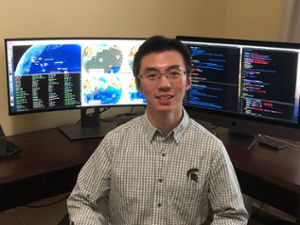Ask the expert: Understanding the nature of big earthquakes
"Ask the Expert" articles provide information and insights from MSU scientists, researchers and scholars about national and global issues, complex research and general-interest subjects based on their areas of academic expertise and study. They may feature historical information, background, research findings, or offer tips. 

Songqiao “Shawn” Wei, an Endowed Assistant Professor of Geological Sciences in the Department of Earth and Environmental Sciences in the College of Natural Science at Michigan State University has been studying the earthquakes in response to Earth’s tectonic plate movement around the world.
What is an earthquake?
An earthquake is a sudden motion of the Earth caused by slips of rocks (where they are broken) on one fault or a portion of it. For small earthquakes, the fault rupture (rock slip) usually occurs within seconds and on a scale of meters. But the largest earthquakes can rupture over hundreds of miles in minutes. The seismic waves (energy) generated by large earthquakes can propagate (travel) through the Earth and reach the other side of the planet in tens of minutes.
Is there more earthquake activity than usual?
No. There have been several statistical studies showing that earthquake activity is almost constant over the past decades. However, with more and better instrumentation all over the world and better detection technology, we are indeed recording many more earthquakes than before. This increasing dataset will help us better understand the physics of earthquakes and ultimately mitigate earthquake hazards.
How are earthquakes detected?
Seismologists worldwide operate permanent or temporary seismic stations to monitor earthquakes. These seismic stations use very sensitive seismometers to record ground motions that are too weak to be felt by humans — that’s why a seismic station in East Lansing can record the 2011 Tohoku earthquake in Japan whereas no one in Michigan ever felt it.
The recorded ground motions can be caused by earthquakes, but also by any kinds of human activities (e.g., traffic) or natural phenomena (e.g., hurricanes or ocean waves). So it is challenging to distinguish the ground motions caused by earthquakes from other sources. In the past, experience data analysts need to visually examine all data to identify earthquakes. However, in recent years, by using advanced computational technologies, particularly machine learning algorithms, we are automating the earthquake detection process, which saves a lot of time and human resources.
How is your current research related to earthquakes? What are you studying?
As a seismologist, studying earthquakes is one of my major research interests. My group is studying the Alaska subduction zone where the Pacific tectonic plate dives into the Earth’s interior along the Alaska-Aleutian oceanic trench and moves underneath the North American plate. Millions of earthquakes, including the 1964 Great Alaskan earthquake (magnitude 9.2, the most powerful earthquake recorded in North American history), occur in this subduction zone as the two tectonic plates collide and deform.
We are particularly interested in the Alaska Peninsula region, where a magnitude 7.8 earthquake occurred in July 2020 and another magnitude 8.2 earthquake occurred in July 2021 next to the previous one. More specifically, my research group is imaging the Earth’s structure beneath this region — from the Earth’s surface to 200 kilometers (124 miles) depth — and detecting more earthquakes using state-of-the-art machine learning algorithms.
We are also collaborating with my geodesy colleagues Jeffrey Freymueller and Julie Elliott to better understand the nature of these earthquakes from both seismological and geodetic (measuring Earth’s size and shape) perspectives. Eventually, I hope our studies will answer the questions about why the 2020 and 2021 big earthquakes happened at those locations and what controlled their magnitudes.
Banner image: An earthquake is a sudden motion of the Earth caused by slips of rocks (where they are broken) on one fault or a portion of it. For small earthquakes (such as the one pictured above), the fault rupture (rock slip) usually occurs within seconds and on a scale of meters. But the largest earthquakes can rupture over hundreds of miles in minutes. Credit: Dave Goudreau/unsplash